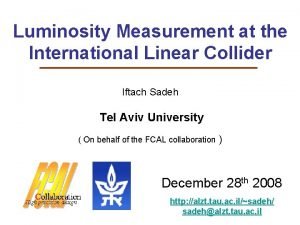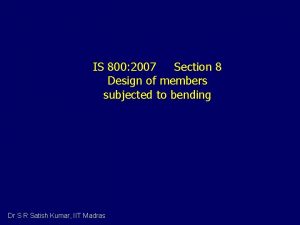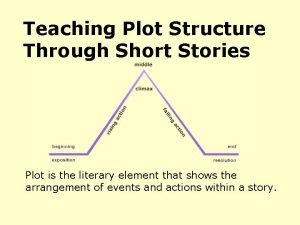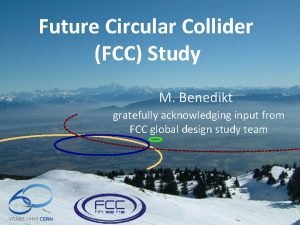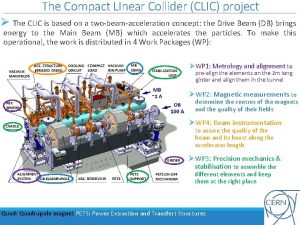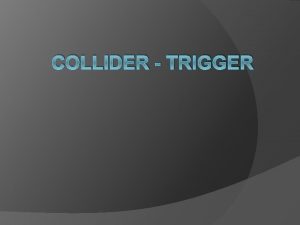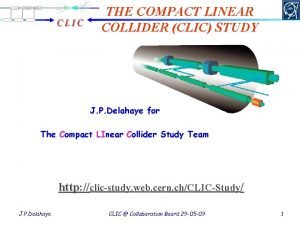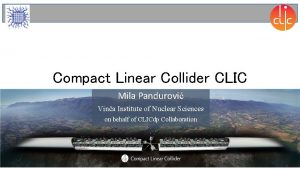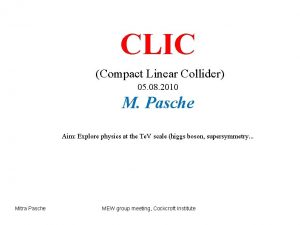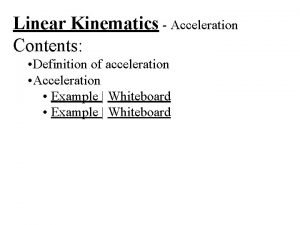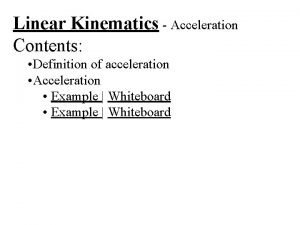CLIC Compact Linear Collider The Acceleration of Intense








- Slides: 8

CLIC Compact Linear Collider The Acceleration of Intense Particle Beams 05/08/2010 Joshua Richards Imperial College London / The Ogden Trust 1

Why is CLIC needed? • Ge. V energy scale has been studied by many accelerators. • Can’t expect LHC to answer all questions. • Colliding Hadrons has its limitations. Standard model modified with super symmetry [1] http: //www. physics. gla. ac. uk/ppt/susy. htm 05/08/2010 Joshua Richards Imperial College London / The Ogden Trust 2

CLIC Characteristics • • Electron-Positron collider. Linear Accelerator. Normal Conducting. Designed to be cost effective. Parameters Designed Value Units Centre-of-mass Energy 3 Te. V Operating Frequency 11. 9942 GHz Luminosity 5. 9 x 1034 cm-2 s-1 Site Length 48. 4 km Accelerating Gradient 100 MVm-1 05/08/2010 Joshua Richards Imperial College London / The Ogden Trust 3

Accelerating the beam. • High desired energy, so high accelerating gradient needed Large number of Klystrons required. • Instead, Two Beam Acceleration (TBA) is used. Two main issues: 1. Electrical Breakdown 2. Wakefield Generation. CLIC two beam accelerator concept [2] http: //www. linearcollider. org 05/08/2010 Joshua Richards Imperial College London / The Ogden Trust 4

Wakefield Suppression • An infinite number of modes are excited. • The lowest, fundamental, mode directs the beam. • All higher modes (lowest dipole especially) kick the beam from its path, diluting its emittance. • It is necessary to remove energy from these modes – using a damping mechanism. Monopole mode [3] “A Damped and Detuned Accelerating Structure for the Main Linacs of the Compact Linear Collider” – Vasim Khan, 2010. Page 86. 05/08/2010 Dipole mode [4] “A Damped and Detuned Accelerating Structure for the Main Linacs of the Compact Linear Collider” – Vasim Khan, 2010. Page 114. Joshua Richards Imperial College London / The Ogden Trust 5

Damped and Detuned Structure (CLIC DDS_A) • This is a proposed alternate structure for the main Linacs. • The diagram shows 1 cell from a series of 24 making up one structure (140, 000 structures in total). • Iris radius tapirs from 4. 0 mm to 2. 3 mm throughout structure – spreads dipole frequencies. • Cavity radius simultaneously changed to maintain accelerating frequency. • 2π/3 phase advance per cell. [5] – Vasim Khan, 2010 “A Damped and Detuned Accelerating Structure for the Main Linacs of the Compact Linear Collider” Page 240. 05/08/2010 Joshua Richards Imperial College London / The Ogden Trust 6

What I have done: Simulations • Using HFSS, some basic simulations of elliptical cells have been produced. Using Mathematica, the value of b (cavity radius of cell) has been optimised for a frequency of 11. 9942 GHz E field variation throughout the cell 05/08/2010 Joshua Richards Imperial College London / The Ogden Trust Using Mathematica, a dispersion curve for the cell has been produced. 7

My tasks for the next 6 weeks • Working on the monopole circuit model. • For a 1 Te. V CLIC, TBA can potentially be replaced by klystrons. • I will be exploring the possibility of a 1 Te. V CLIC using klystrons and will be performing the Beam Loading calculations for this and determining the number of Klystrons required. • Time permitting, examine 5π/6 phase advance. 05/08/2010 Joshua Richards Imperial College London / The Ogden Trust 8


